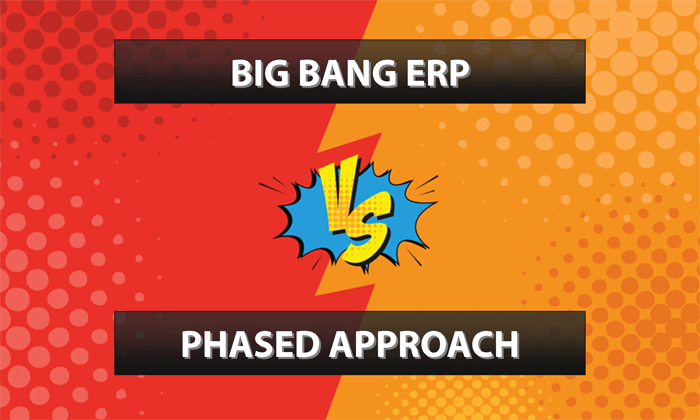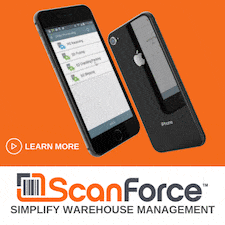Don’t panic. This handy guide will help you understand the big bang vs. phased approach to ERP implementation, so you can move forward confidently.
Let’s get started.
Brief Overview of ERP Implementation Options
Since the point of an Enterprise Resource Planning system (ERP) is to improve workflow and efficiency across your entire business, you’ll have to plan carefully to make sure the software is configured properly and your employees are trained to use the system the way it is intended in order to achieve the results you want.
There are two popular ways to achieve this:
1.The Big Bang ERP Implementation
In the “big bang” method, everyone in your company will start using the system (go live) on the same day. In short, you're taking all of the modules live at once.
It’ll be like turning off your old system and then immediately firing up your new system. Exciting right?
But, like the actual Big Bang, it creates a whole universe of change all at once.
To prepare you for a successful kickoff (called the “go live” in the ERP world), your consultant will spend months converting and transferring data into your new system, as well as testing, training your staff, customizing the software and connecting it with add-ons as needed, and testing some more. In fact, they’ll spend a lot of time testing, because the golden rule of ERP implementations is that the more you test, the better your implementation will be.
2.The Phased ERP Implementation
An alternative to big bang, a "Phased ERP Implementation" rolls your software out sequentially, gradually introducing the new system piece by piece.
Rather than one big go live date for the entire system, a phased implementation has several smaller go live dates for each phase of the project (accounting, inventory, etc.) which can give your staff more time to adjust to changes.
Common “phases” include breaking down the implementation by module, business unit, geographical area, or business priority.
Because your company must perform different functions in the ERP system during a phased implementation, preparation typically includes training your staff on standard operating procedures that they should use during the interim period. Your ERP consultant will also likely develop temporary interfaces between your new system and your legacy system so you don’t lose critical data while you’re phasing in the new ERP.
Bonus Option: The Parallel Installation
A third option is to run both systems - the old legacy software and new ERP system - in parallel. In short, you're running two software systems at the same time. While this method provides a nice safety net for your staff to learn the new software at their own pace while still having access to the old system that they're still familiar and comfortable with, this implementation style comes with higher costs and can be more error-prone which makes it unrealistic for many companies.
It’s Okay to Combine ERP Implementation Methods
It may help to learn that none of these methods are required for your company. You don’t have to think of it as a big bang versus phased approach in which a single option is the right answer; it’s okay to choose a mix-and-match process of big bang and phased implementation for your company.
One popular combination strategy uses a big bang implementation style for core modules (accounting, payables, receivables) but switches to a phased method for non-core modules and activities like document management, business intelligence, and 3rd party applications.
Pros and Cons of Big Bang Implementation
Comprehensive, end-to-end testing and data validation will help you identify incompatibility problems and bugs, but you’ll never be able to test for every possible scenario – and if something goes wrong in one area, it could create problems for your entire ERP Implementation.
In addition, a big bang implementation will definitely lead to a temporary lack of productivity across the company as your staff scrambles to remember the training they received over the prior months and may tend to fall back into old habits or get stuck when the new system doesn't work the way the old one did.
Pros and Cons of Phased Implementation
However, the longer timelines in a phased roll out will lead to higher implementation and consulting costs as well as a delay in your return on investment cycle. Plus, you may need to allocate additional budget to the development of interface tools that will connect your two systems together during the interim period.
And for some companies, phased implementations can also cause potential problems with regulatory compliance or M&A stipulations.
Big Bang vs. Phased Approach: It’s a Personal Decision
But no matter which methodology you choose, make sure that you carefully plan every step of your transition with your ERP consultant and allocate sufficient time for staff training. After all, there are simply too many stories of failed ERP implementation projects for no other reason than inadequate training and executive planning.
A successful ERP implementation will lead to increased sales and revenues, reduced operating costs, and improved organizational efficiency, which means you have a lot to look forward to in the coming months – but plan for success by making sure that your implementation creates the minimum disruption to your business operations, with a timeline and cost structure that makes sense to you.
The best implementation strategy for your company is one that balances the lowest cost with the lowest risk.
Not sure which option is the right choice for your company?
Today’s top ERP software providers have spent a decade or more performing successful ERP implementations and developing a unique set of skills to help your company through a smooth transition.
Just click below to find a top ERP consultant in your area.




